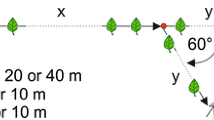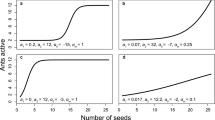Summary
Paraponera clavata foragers employ a trail pheromone and activation within the nest to obtain mass recruitment to simulated nectar sources. Foragers leaving and returning to the nest normally follow the same path. The existence of a trail pheromone was inferred from a series of experiments in which different techniques were employed to disrupt main foraging routes. Individuals baited to simulated nectar sources were observed to drag their gasters in a distinctive fashion when returning to the main trail. The return of an individual from a bait site resulted in greatly increased foraging activity from the colony. A maximum of 352 individuals were recruited within an hour following presentation of the bait. Recruited individuals were able to find the bait site in the absence of the initial forager by following the path taken by the initial forager. Even under normal, unbaited, conditions ants leave colonies in a temporal sequence that suggests social facilitation.
Resume
Les fourragères deParaponera clavata emploient une phéromone de piste et l'activation dans le nid pour obtenir un recrutement de masse vers des sources de nectar artificielles. Les fourragères allant et revenant au nid suivent normalement la même direction. L'existence d'une phéromone de piste découle d'une série d'expériences dans lesquelles différentes techniques furent employées afin de rompre les principales routes de fourragement. Des individus attirés vers des sources de nectar artificielles furent observés tirant leur abdomen d'une manière particulière en retournantà la piste principale. Le retour de l'individu du site de l'appât provoqua un grand accroissement de l'activité de fouraagement de la colonie. Un maximum de 352 individus fut recruté dans l'heure suivant la présentation de l'appât. Des individus recrutés furent capables de trouver le site de l'appât en l'absence de la fourragère initiale en suivant la direction prise par cette dernière. Même dans des conditions normales, sans appât, les fourmis quittent les colonies dans une séquence temporelle qui suggère une facilitation sociale.
Similar content being viewed by others
References
Benknett B., Breed M.D., in press. — On the ossociation betweenPentaclethra macroloba (Mimosaceae) andParaponera clavata (Hymenoptera: Formicidae) colonies.Biotropica.
Evans H.C., Leston D., 1971. — A ponerine ant associated with Homoptera on cocoa in Ghana.Bull. Entomol. Res., 61, 357–362.
Fletcher D.J.C., 1971. — The glandular source and social function of trall pheromones in two species of ants (Leptogenys).J. Entomol. A., 46, 27–37.
Hermann H.R., 1973. — Formation of preforage aggregations in ponerine ants; a possible step toward group raiding.J. Georgia Entomol. Soc., 8, 185–186.
Hermann H.R., 1975. — Crepuscular and nocturnal activities ofParaponera clavata (Hymenoptera: Formicidae: Ponerinae).Entomological News, 86, 94–98.
Hölldobler B., 1971. — Recruitment behavior inCamponotus socius (Formicidae).Z. Vergl. Physiol., 75, 123–142.
Hölldobler B., 1977. — Communication in social Hymenoptera. In:How Animals Communicate (ed. Th. A. Sebeok) Bloomington, Indiana Press, p. 418–471.
Hölldobler B., 1978. — Ethological aspects of chemical communication in ants.Adv. Study Anim. Behav., 8, 75–115.
Hölldobler B., 1983. — Communication during foraging and nest-relocation in the African Stink Ant,Paltothyreus tarsatus Fabr.Z. Tierpsychol.
Hölldobler B., Lumsden C.J., 1980. — Territorial strategies in ants.Science, 210, 732–739.
Hölldobler B., Traniello J.F.A., 1980 a. — Tandem running in ponerine ants.Naturwiss., 67, 360.
Hölldobler B., Traniello J.F.A., 1980 b. — The pygidial gland and chemical recruitment communication inPachycondyla laevigata.J. Chem. Ecol., 6, 883–893.
Hölldobler B., Wilson E.O., 1977. — Colony-specific territorial pheromone in the African weaver antOecophylla longinoda (Latreille).Proc. Natl. Acad. Sci., U.S.A., 74, 2072–2075.
Jaffe K., Howse P.E., 1979. — The mass recruitment system of the leaf cutting ant,Atta cephalotes (L.).Anim. Behav., 27, 930–949.
Janzen D.H., Carroll C.R., 1983. —Paraponera clavata. In:Costa Rican Natural History (ed. D.H. Janzen), p. 752–753, Univ. of Chicago Press, Chicago.
Lachaud J.P., 1984. — Mise en évidence d'un recrutement de masse archaïque chez une ponerinae néotropicale:Ectatomma. ruidum.Actes Coll. Ins. Soc., 1, 107–111.
Mann W.M., 1916. — The ants of Brazil.Bull. Mus. Comp. Zool. Harvard, 60, 307–490.
Maschwitz U., Hölldobler B., Moglich M., 1974. — Tandemlaufer als Rebrutierunopuerhallen beiBothroponera tesserinoda Forel (Formicidae, Ponerinae).Z. Tierpsychol., 35, 113–123.
Maschwitz U., Muhlenberg M., 1975. — Zur Jugdstrategie einiger orientalischerLeptogengys Arten.Oecologia, 20, 65–83.
Mc Cluskey E.S., Brown W.L., 1972. — Rhythms and other biology of the giant tropical antParaponera.Psyche, 79, 335–347.
Moglich M., 1973. — Communication during nest-moving in ants.Proc. VIIth Int. Congress, I.U.S.S.I., London.
Moglich M., Hölldobler B., 1975. — Communication and orientation during foraging and emigration in the antFormica fusca.J. Comp. Physiol., 101, 275–288.
Traniello J.F.A., 1983. — Social organization and foraging success inLasius neoniger (Hymenoptera: Formicidae): behavioral and ecological aspects of recruitment communication.Oecologia (Berlin),59, 94–100.
Valenzuela J., Lachaud J.P., 1982. — Observaciones preliminares sobre la importancia deEctatomma tuberculatum Olivier como control del algunos insectos plaga sobre plantas de cafe y cacao en el soconusco.X Reunion Nacional de Control Biologico, Durango, Mexico.
Wilson E.O., 1971. —The Insect Societies, Harvard Univ. Press, Cambridge, Mass.
Young A.M., Hermann H.R., 1980. — Notes on foraging of the giant tropical antParaponera clavata (Hymenoptera: Formicidae: Ponerinae).J. Kansas Entomol. Soc., 53, 35–55.
Author information
Authors and Affiliations
Rights and permissions
About this article
Cite this article
Breed, M.D., Bennett, B. Mass recruitment to nectar sources inParaponera clavata: A field study. Ins. Soc 32, 198–208 (1985). https://doi.org/10.1007/BF02224233
Received:
Accepted:
Issue Date:
DOI: https://doi.org/10.1007/BF02224233




